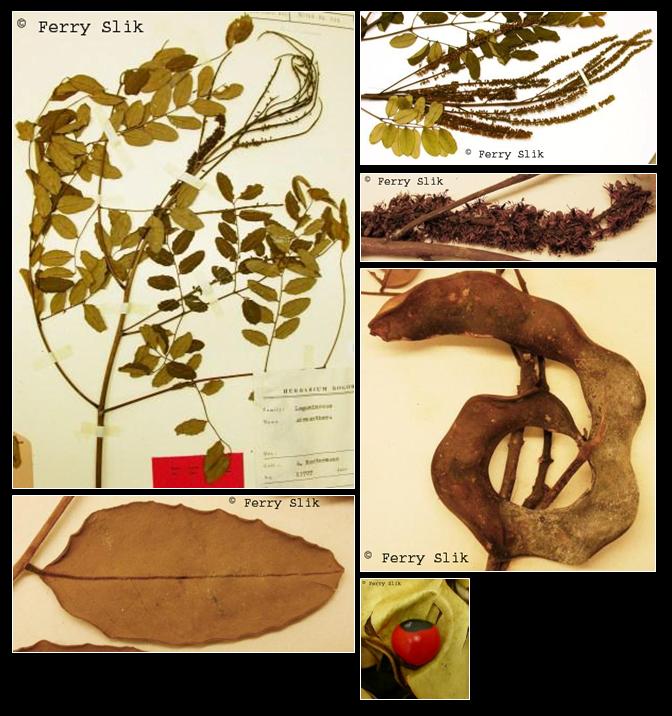Adenanthera kostermansii Nielsen, Nordic J. Bot. 12 (1992)
Named after A.J.G.H. Kostermans [1906-1994], a Dutch botanist.Description
Tree to 39 m high, d.b.h. 98 cm. Buttresses sharp and narrow, to 2.5 m high and 20 cm wide, sometimes
with a tendency to stiltroot habit. Bark pale brown to chocolate brown, smooth to finely cracked; sapwood
white to dirty white; heartwood dark brown. Branchlets puberulous, with a mixture of glandular and nonglandular
hairs. Stipules not seen. Leaves: rachis (8-)9-20(-24) cm, adaxially sulcate, puberulous
by patent hairs; pinnae (2-)3-4(-5) pairs, puberulous by patent hairs, (1.5-)4.5-16 cm; petiolule
1-1.5 mm, patently puberulous; leaflets 4-8(-10) on each side of the pinna, thinly chartaceous, drying
dull grey-green, sometimes glaucous beneath, ca. asymmetrically narrowly elliptic, ovate to obovate-
elliptic or subtrapezoid (0.8-)1.4-3.5 by (0.2-)0.9-2 cm; base ca. asymmetrically cuneate
to truncate-rounded in the acroscopic portion and cuneate in the distal part; apex broadly acute to
rounded or truncate(-emarginate), usually mucronulate; upper surface sparsely puberulous, lower
surface puberulous, especially densely so on the main vein; lateral veins prominulous, c. 8-10 per
leaflet-half, slightly arching, not parallel. Racemes (incl. peduncle) 6-10(-16) cm, densely puberulous
by golden hairs (when dry) and scattered glandular hairs; pedicel 1-1.6 mm, appressed or patently
puberulous, floral bracts filiform, 0.5 mm, puberulous, caducous. Calyx broadly cup-shaped to subrotate,
0.3-0.5 mm, appressed to patently puberulous; teeth triangular, acute, c. 0.1 mm. Petals
yellow to yellowish white, elliptic-lanceolate, 2.5-4 mm, acute, glabrous. Stamens yellow to
yellowish white, 3-4 mm; anthers greenish yellow, 0.5 mm. Ovary greenish yellow, glabrous,
c. 1.5 mm, style 1.5 mm, stigma light green. Pod black, linear-oblong, contorted, after dehiscence
spirally twisted, at least 11 by 1.4-1.6 cm. Seeds glossy red with black spot distally, ca. symmetrically
suborbicular to obovoid in outline, c. 7 by 6.5-7 by 4 mm; black spot c. 4 mm wide by 1.5
mm high; pleurogram 6 by 5-6 mm, parallel to the margin, open towards the hilum. [from Flora Malesiana]
Ecology
In undisturbed mixed dipterocarp forests up to 700 m altitude. Mostly on
hillsides and ridges with various soils including sandy, yellow sandy clay
and limestone. Also found in peat- and fresh-water-swamps. In secondary forests
usually present as a pre-disturbance remnant tree.
Distribution
Sumatra, Borneo, southern Philippines.
Local names
Borneo: Berayung, Peliong, Saga, Tampilik.
